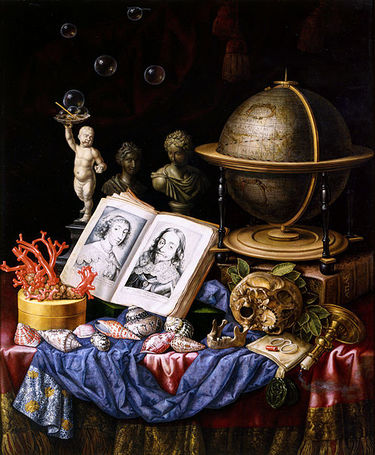Allegory of Charles I of England and Henrietta of France in a Vanitas
The Allegory of Charles I of England and Henrietta of France in a Vanitas is a 57 1/2" by 47 1/4" oil painting on canvas in the collection of the Birmingham Museum of Art. It was painted after 1649 by an unknown artist, likely working in Paris. It was purchased by the museum at auction in 1988.
The painting is a still-life, realistically depicting an arrangement of objects, all of which allude to life's emptiness and fragility. The genre was popular among Northern European artists in the 17th century, and reflects an attitude inspired by the Old Testament book of Ecclesiastes ("Vanity of vanities, saith the preacher; all is vanity.")
Among the objects depicted in the Allegory is a book with portraits of Charles I (1600-1649) and his wife, Henriette Marie (1610-1669). Although not as flattering, her portrait resembles, in her pose, jewelry and dress, a 1689 engraving by Cornelius Nicolaus Schurtz (1630-1690) which was published in Nürnberg in Johann Christoph Beer's Das Neu-Geharnische Großbritannien.
Henrietta and Charles were both well-regarded for their appreciation of painting and for their impressive art collection. Charles, however, fell afoul of Parliament for favoring his purse over the good of the country and was convicted of treason at a High Court of Justice and subsequently executed by beheading before Whitehall. Most of the former king's collection was sold off by Parliament to redeem debts incurred during the English Civil War.
Surrounding the book are a broken skull crowned with laurel, a snuffed candle, a blank parchment with sealing wax and a pince-nez. Behind them is a globe resting atop an atlas, a piece of coral on a wood casket, and several cowrie shells. Behind the book are two female portrait busts in classical dress, and a sculpture of a putto lofting a scallop shell in which rest a pipette and several soap bubbles, four of which drift up into the air. The broken skull and snuffed candle allude to the imminence of death. The atlas and globe point toward the empire's worldly riches while the blank parchment and eyeglasses provide an opportunity for an honest account of one's deeds. The cowries represent the body cast off by the departure of the spirit, while the seal the coral offers protection from evil and the laurel symbolizes victory over death.
In the 20th century, the painting was owned by long-serving French minister Robert Boulin, who committed suicide in the forest of Rambouillet while under a cloud of corruption allegations. It was sold by his estate to an art dealer in Lyon, who had the panel cleaned, then sold it to psychiatrist, crime novelist, and sometimes art dealer Patrick Weiller. Weiller offered the painting to the Birmingham Museum of Art for $100,000 in 1985, but the offer was not accepted. (The museum did purchase Jan Mijtens' 1654 "Portrait of the van der Graeff Family" from Weiller that year.)
In November 1986 the Vanitas painting, then attributed to the French artist Renard de St André, sold for $80,000 at an auction held by Sotheby's Monaco. It came into the hands of Judy Taubman, former Miss Isreal and second wife of Sotheby's owner A. Alfred Taubman. The painting suffered minor damage during shipment back to New York, and she turned it over to the insurer, which brought it back to auction at Sotheby's New York in 1988.
The Birmingham Museum of Art purchased the artwork with funds contributed by Martee Woodward Webb; Mr and Mrs Edmund England; Dr and Mrs Rex Harris; Mrs William McDonald Jr; Mr and Mr. Stewart Dansby; and Ms Pauline Tutwiler.
Like many other works formerly attributed to Renard, the Allegory of Charles I of England and Henrietta of France was later credited to the Antwerpen-born Carstian Luyckx who worked in Paris and had influenced Renard.
References
- Birmingham Museum of Art (1993) Masterpieces East & West: From the collection of the Birmingham Museum of Art. Birmingham, Alabama: Birmingham Museum of Art. ISBN 0931394384
- Kelley, Raymond J. III (2006) To Be or Not to Be: Four Hundred Years of Vanitas Painting. Flint Institute of Arts. ISBN 0939896257
- Hrynkiw, Ivana (October 12, 2018) "This local couple's wedding was inspired by a painting." The Birmingham News
